 “The Tyrant Fly-catcher, or, as it is commonly named, the Field Martin, or King Bird, is one of the most interesting visitors of the United States, where it is to be found during spring and summer, and where, were its good qualities appreciated as they deserve to be, it would remain unmolested. But man being generally disposed to consider in his subjects a single fault sufficient to obliterate the remembrance of a thousand good qualities, even when the latter are beneficial to his interest, and tend to promote his comfort, persecutes the King Bird without mercy, and extends his enmity to its whole progeny. This mortal hatred is occasioned by a propensity which the Tyrant Fly-catcher now and then shews to eat a honey-bee, which the narrow-minded farmer looks upon as exclusively his own property, although he is presently to destroy thousands of its race, for the selfish purpose of siezing upon the fruits of their labours, which he does with as little remorse as if nature’s bounties were destined for man alone.”
“The Tyrant Fly-catcher, or, as it is commonly named, the Field Martin, or King Bird, is one of the most interesting visitors of the United States, where it is to be found during spring and summer, and where, were its good qualities appreciated as they deserve to be, it would remain unmolested. But man being generally disposed to consider in his subjects a single fault sufficient to obliterate the remembrance of a thousand good qualities, even when the latter are beneficial to his interest, and tend to promote his comfort, persecutes the King Bird without mercy, and extends his enmity to its whole progeny. This mortal hatred is occasioned by a propensity which the Tyrant Fly-catcher now and then shews to eat a honey-bee, which the narrow-minded farmer looks upon as exclusively his own property, although he is presently to destroy thousands of its race, for the selfish purpose of siezing upon the fruits of their labours, which he does with as little remorse as if nature’s bounties were destined for man alone.”
–J. J. Audubon, Ornithological Biography, I (1831), 403 [excerpted].
Comments Off on The Tyrant Fly-catcher (Audubon “bird of the week”)
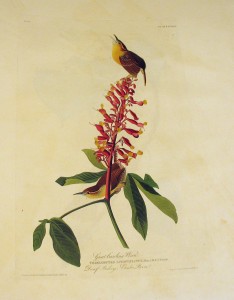 “The quickness of the motions of this active little bird is fully equal to that of the mouse. Like the latter, it appears and is out of sight in a moment, peeps into a crevice, passes rapidly through it, and shews itself at a different place the next instant. When satiated with food, or fatigued with these multiplied exertions, the little fellow stops, droops its tail, and sings with great energy a short ditty something resembling the words come-to-me, come-to-me, repeated several times in quick succession, so loud, and yet so mellow, that it is always agreeable to listen to them. During spring, these notes are heard from all parts of the plantations, the damp woods, the swamps, the sides of creeks and rivers, as well as from the barns, the stables and the piles of wood, within a few yards of the house.”
“The quickness of the motions of this active little bird is fully equal to that of the mouse. Like the latter, it appears and is out of sight in a moment, peeps into a crevice, passes rapidly through it, and shews itself at a different place the next instant. When satiated with food, or fatigued with these multiplied exertions, the little fellow stops, droops its tail, and sings with great energy a short ditty something resembling the words come-to-me, come-to-me, repeated several times in quick succession, so loud, and yet so mellow, that it is always agreeable to listen to them. During spring, these notes are heard from all parts of the plantations, the damp woods, the swamps, the sides of creeks and rivers, as well as from the barns, the stables and the piles of wood, within a few yards of the house.”
–J. J. Audubon, Ornithological Biography, I (1831), 399 [excerpted].
Comments Off on The Great Carolina Wren (Audubon “bird of the week”)

We were thrilled to see over 70 people (families and friends of graduating seniors) come through the Watkinson today! On display is, of course, the famous Audubon (Birds of America), several books recently acquired and given (including the 2nd Folio of Shakespeare), as well as a small student exhibition and the main exhibit on Hyam Plutzik.

Comments Off on Commencement weekend!
 We bid a fond farewell with best wishes to Michael Kozek ’13, who has worked for the Watkinson for his entire time at Trinity (with the exception of the “study abroad” semester he spent in Argentina). Majoring in Language & Cultural Studies and Political Science, Michael wrote a thesis in Spanish entitled “Logros, Desafíos y Justicia: La cultura política LGBTQ en Argentina e Italia.” In the fall, Michael will attend graduate school at the University of Chicago to pursue Latin American studies.
We bid a fond farewell with best wishes to Michael Kozek ’13, who has worked for the Watkinson for his entire time at Trinity (with the exception of the “study abroad” semester he spent in Argentina). Majoring in Language & Cultural Studies and Political Science, Michael wrote a thesis in Spanish entitled “Logros, Desafíos y Justicia: La cultura política LGBTQ en Argentina e Italia.” In the fall, Michael will attend graduate school at the University of Chicago to pursue Latin American studies.
Michael is shown here standing by a small exhibition he recently curated (on display through June 15) entitled “The Corvo Papers: The OSS in Italy during WW II.” The exhibit offers a selection of items from a collection of intelligence reports, photos, and correspondence from fascist Italy (1943-45), given to Trinity by William Corvo, the son of Biagio “Max” Corvo, a decorated Major in the Office of Strategic Services (OSS, the precursor to the CIA). The collection includes formerly sensitive documents (and some very graphic photos) that reveal how the OSS contributed to a strategic advantage that helped to bring down Mussolini’s administration and turn Italy toward the Allied cause.
Comments Off on Swan Song (and a great research opportunity!)
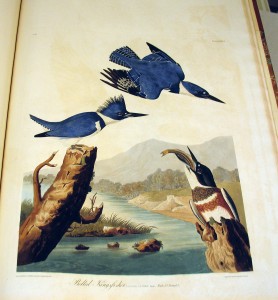 “The more usual range of the Belted Kingfisher . . . is confined to the rivers and creeks that abound throughout the United States; all of which, according to the seasons, are amply supplied with various fishes, on the fry of which this bird feeds. It follows their course up to the very source of the small rivulets; and it is not unusual to hear the hard, rapid, rattling notes of our Kingfisher, even amongst the murmuring cascades of our higher mountains. When the bird is found in such sequestered situations, well may the angler be assured that trout is abundant. Mill-ponds are also favorite resorts of the Kingfisher, the usual calmness of the water in such places permitting it to discover its prey with ease.”
“The more usual range of the Belted Kingfisher . . . is confined to the rivers and creeks that abound throughout the United States; all of which, according to the seasons, are amply supplied with various fishes, on the fry of which this bird feeds. It follows their course up to the very source of the small rivulets; and it is not unusual to hear the hard, rapid, rattling notes of our Kingfisher, even amongst the murmuring cascades of our higher mountains. When the bird is found in such sequestered situations, well may the angler be assured that trout is abundant. Mill-ponds are also favorite resorts of the Kingfisher, the usual calmness of the water in such places permitting it to discover its prey with ease.”
–J. J. Audubon, Ornithological Biography, I (1831), 395 [excerpted].
Comments Off on The Belted Kingfisher (Audubon “bird of the week”)
 “The common name given to this bird in the Eastern and Middle districts of our Union is that of Quail, but in Western and Southern states, the more appropriate appellation of Partridge is bestowed upon it. It is abundantly met with in all parts of the United States, but more especially towards the interior. In the states of Ohio and Kentucky, where they are very abundant, they are to be seen in the markets, both dead and alive, in large quantities.
“The common name given to this bird in the Eastern and Middle districts of our Union is that of Quail, but in Western and Southern states, the more appropriate appellation of Partridge is bestowed upon it. It is abundantly met with in all parts of the United States, but more especially towards the interior. In the states of Ohio and Kentucky, where they are very abundant, they are to be seen in the markets, both dead and alive, in large quantities.
This species performs occasional migrations from the north-west to the south-east, usually in the beginning of October, and somewhat in the manner of the Wild Turkey. For a few weeks at this season, the northwestern shores of the Ohio are covered with flocks of Partridges. They ramble through the woods along the margin of the stream, and generally fly across towards evening. Like the Turkeys, many of the weaker Partridges often fall into the water, while thus attempting to cross, and generally perish; for although they swim surprisingly, they have not muscular power sufficient to keep up a protracted struggle, although, when they have fallen a few yards of the shore, they easily escape being drowned.”
–J. J. Audubon, Ornithological Biography, I (1831), 388 [excerpted].
Comments Off on The Virginian Partridge (Audubon “bird of the week”)
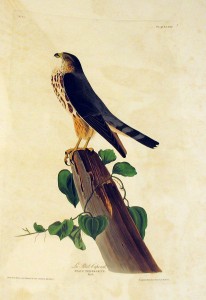 “This beautiful little hawk appears to be nearly allied to the European Hobby (Falco Subbuteo, Linn.) and is not inferior to that species in spirit and activity. I procured the individual represented, in April 1812, near Flatland Ford in Pennsylvania, whilst in pursuit of a Dove, which it would doubtless have secured, had I not terminated its career. When I first discovered this species, the individual was standing perched on an old fence-stake, in the position in which it is figured. Never having met with another of its kind, I conclude that it is extremely rare in the United States. Of its nest or young I am unable to say anything at present.
“This beautiful little hawk appears to be nearly allied to the European Hobby (Falco Subbuteo, Linn.) and is not inferior to that species in spirit and activity. I procured the individual represented, in April 1812, near Flatland Ford in Pennsylvania, whilst in pursuit of a Dove, which it would doubtless have secured, had I not terminated its career. When I first discovered this species, the individual was standing perched on an old fence-stake, in the position in which it is figured. Never having met with another of its kind, I conclude that it is extremely rare in the United States. Of its nest or young I am unable to say anything at present.
The name which I have given to this new and rare species was chosen at the time when Napoleon Le Grand was in the zenith of his glory. Every body knows that his soldiers frequently designated him by the nickname of Le Petit Caporal, which I thought more suitable to our little Hawk, than the names Napoleon or Bonaparte, which I should have adopted, had I been so fortunate as to procure a new Eagle.
–J. J. Audubon, Ornithological Biography, I (1831), 381 [excerpted].
[Curator’s note: this bird is actually a Merlin]
Comments Off on Le Petit Caporal (Audubon “bird of the week”)
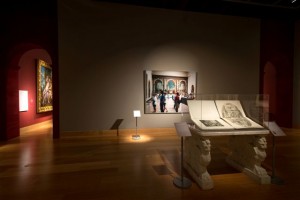 We are happy to welcome back our copy of Valentin Lefebvre’s Opera Selectiora (Venice, 1682), which we loaned to the John and Mable Ringling Museum of Art in Sarasota, for an exhibition on Paolo Veronese. Shown here is a shot of the book in their gallery.
We are happy to welcome back our copy of Valentin Lefebvre’s Opera Selectiora (Venice, 1682), which we loaned to the John and Mable Ringling Museum of Art in Sarasota, for an exhibition on Paolo Veronese. Shown here is a shot of the book in their gallery.
The museum published a lavish catalog, a copy of which we received for contributing to the show.
Comments Off on Welcome back!
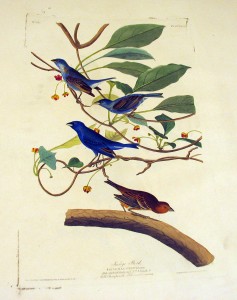 “The Indigo Bird arrives in the Southern States from the direction of Mexico, along with its relative the Painted Finch, and is caught in trap-cages, but with more difficulty than the latter bird. It spreads far and wide over the United States, extending from the borders of our Atlantic shores to those of our great lakes. It is not a forest bird, but prefers the skirts of the woods, the little detached thickets in and along the fields, the meadows, the gardens, and orchards, and is frequently seen hopping along, or perched on a fence, from which is does not disdain to send forth its pretty little song . . .
“The Indigo Bird arrives in the Southern States from the direction of Mexico, along with its relative the Painted Finch, and is caught in trap-cages, but with more difficulty than the latter bird. It spreads far and wide over the United States, extending from the borders of our Atlantic shores to those of our great lakes. It is not a forest bird, but prefers the skirts of the woods, the little detached thickets in and along the fields, the meadows, the gardens, and orchards, and is frequently seen hopping along, or perched on a fence, from which is does not disdain to send forth its pretty little song . . .
I have represented an adult female, two young males of the first and second year, in autumn, and a male in the full beauty of its plumage. They are placed on a plant usually called the Wild Sarsparilla.”
–J. J. Audubon, Ornithological Biography, I (1831), 377-379 [excerpted].
Comments Off on The Indigo Bird (Audubon “bird of the week”)

Yesterday we formally opened the exhibition on “Hyam Plutzik ’32, American Poet,” featuring a reading of selected poems by Plutzik by Ciaran Berry (Assistant Professor of English), Clare Rossini (Artist-in-Residence), Dick Allen (Connecticut’s Poet Laureate), and Trinity students Diana Lestz ’13 and Cassie Spittel ’13. All of the readers also read one of their own poems in Plutzik’s honor.
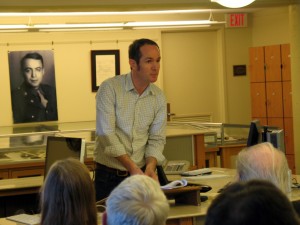 The exhibition was curated by Ed Moran, literary adviser to the Plutzik family, and most of the material was generously lent by the University of Rochester, although some artifacts (like Plutzik’s fishing gear) were lent by the family.
The exhibition was curated by Ed Moran, literary adviser to the Plutzik family, and most of the material was generously lent by the University of Rochester, although some artifacts (like Plutzik’s fishing gear) were lent by the family.
Associate Curator Sally Dickinson and staffer Henry Arneth were instrumental in the installation of the exhibit, which will be on display through the end of May, so that those who come to campus for Commencement will be able to view a slice of the life and work of this accomplished Trinity alum who died well before his time

Comments Off on Past and Present Poetic Voices
 “The quickness of the motions of this active little bird is fully equal to that of the mouse. Like the latter, it appears and is out of sight in a moment, peeps into a crevice, passes rapidly through it, and shews itself at a different place the next instant. When satiated with food, or fatigued with these multiplied exertions, the little fellow stops, droops its tail, and sings with great energy a short ditty something resembling the words come-to-me, come-to-me, repeated several times in quick succession, so loud, and yet so mellow, that it is always agreeable to listen to them. During spring, these notes are heard from all parts of the plantations, the damp woods, the swamps, the sides of creeks and rivers, as well as from the barns, the stables and the piles of wood, within a few yards of the house.”
“The quickness of the motions of this active little bird is fully equal to that of the mouse. Like the latter, it appears and is out of sight in a moment, peeps into a crevice, passes rapidly through it, and shews itself at a different place the next instant. When satiated with food, or fatigued with these multiplied exertions, the little fellow stops, droops its tail, and sings with great energy a short ditty something resembling the words come-to-me, come-to-me, repeated several times in quick succession, so loud, and yet so mellow, that it is always agreeable to listen to them. During spring, these notes are heard from all parts of the plantations, the damp woods, the swamps, the sides of creeks and rivers, as well as from the barns, the stables and the piles of wood, within a few yards of the house.”










